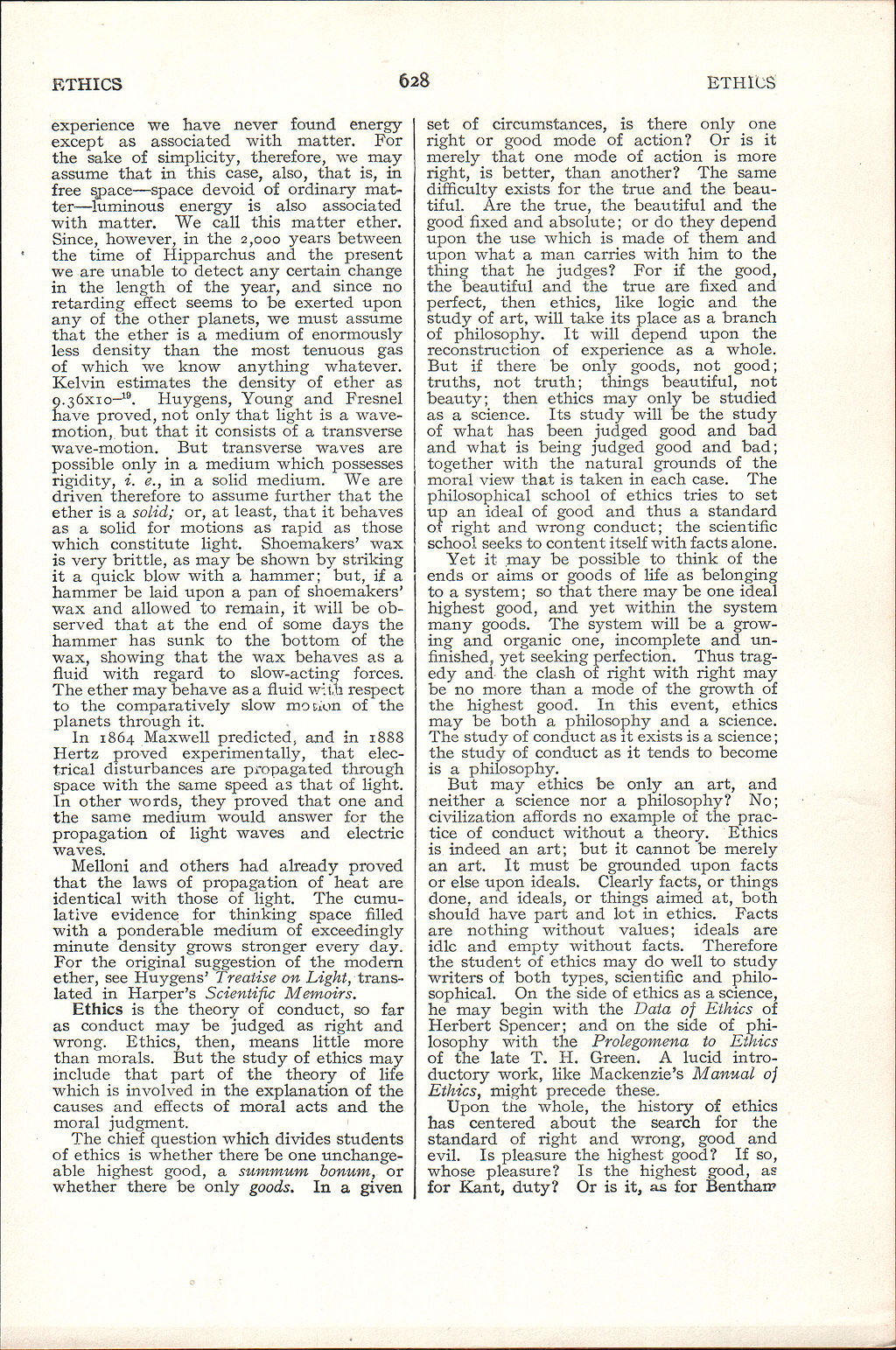Page 628 : ETHICS — ETHICS
Individual articles:
experience we have never found energy except as associated with matter. For the sake of simplicity, therefore, we may assume that in this case, also, that is, in free space—space devoid of ordinary matter—luminous energy is also associated with matter. We call this matter ether. Since, however, in the 2,000 years between the time of Hipparchus and the present we are unable to detect any certain change in the length of the year, and since no retarding effect seems to be exerted upon any of the other planets, we must assume that the ether is a medium of enormously less density than the most tenuous gas of which we know anything whatever. Kelvin estimates the density of ether as 9.36×10−19. Huygens, Young and Fresnel have proved, not only that light is a wave-motion, but that it consists of a transverse wave-motion. But transverse waves are possible only in a medium which possesses rigidity, i. e., in a solid medium. We are driven therefore to assume further that the ether is a solid; or, at least, that it behaves as a solid for motions as rapid as those which constitute light. Shoemakers’ wax is very brittle, as may be shown by striking it a quick blow with a hammer; but, if a hammer be laid upon a pan of shoemakers’ wax and allowed to remain, it will be observed that at the end of some days the hammer has sunk to the bottom of the wax, showing that the wax behaves as a fluid with regard to slow-acting forces. The ether may behave as a fluid with respect to the comparatively slow motion of the planets through it.
In 1864 Maxwell predicted and in 1888 Hertz proved experimentally, that electrical disturbances are propagated through space with the same speed as that of light. In other words, they proved that one and the same medium would answer for the propagation of light waves and electric waves.
Melloni and others had already proved that the laws of propagation of heat are identical with those of light. The cumulative evidence for thinking space filled with a ponderable medium of exceedingly minute density grows stronger every day. For the original suggestion of the modern ether, see Huygens’ Treatise on Light, translated in Harper’s Scientific Memoirs.
Ethics is the theory of conduct, so far as conduct may be judged as right and wrong. Ethics, then, means little more than morals. But the study of ethics may include that part of the theory of life which is involved in the explanation of the causes and effects of moral acts and the moral judgment.
The chief question which divides students of ethics is whether there be one unchangeable highest good, a summum bonum, or whether there be only goods. In a given set of circumstances, is there only one right or good mode of action? Or is it merely that one mode of action is more right, is better, than another? The same difficulty exists for the true and the beautiful. Are the true, the beautiful and the good fixed and absolute; or do they depend upon the use which is made of them and upon what a man carries with him to the thing that he judges? For if the good, the beautiful and the true are fixed and perfect, then ethics, like logic and the study of art, will take its place as a branch of philosophy. It will depend upon the reconstruction of experience as a whole. But if there be only goods, not good; truths, not truth; things beautiful, not beauty; then ethics may only be studied as a science. Its study will be the study of what has been judged good and bad and what is being judged good and bad; together with the natural grounds of the moral view that is taken in each case. The philosophical school of ethics tries to set up an ideal of good and thus a standard of right and wrong conduct; the scientific school seeks to content itself with facts alone.
Yet it may be possible to think of the ends or aims or goods of life as belonging to a system; so that there may be one ideal highest good, and yet within the system many goods. The system will be a growing and organic one, incomplete and unfinished, yet seeking perfection. Thus tragedy and the clash of right with right may be no more than a mode of the growth of the highest good. In this event, ethics may be both a philosophy and a science. The study of conduct as it exists is a science; the study of conduct as it tends to become is a philosophy.
But may ethics be only an art, and neither a science nor a philosophy? No; civilization affords no example of the practice of conduct without a theory. Ethics is indeed an art; but it cannot be merely an art. It must be grounded upon facts or else upon ideals. Clearly facts, or things done, and ideals, or things aimed at, both should have part and lot in ethics. Facts are nothing without values; ideals are idle and empty without facts. Therefore the student of ethics may do well to study writers of both types, scientific and philosophical. On the side of ethics as a science, he may begin with the Data of Ethics of Herbert Spencer; and on the side of philosophy with the Prolegomena to Ethics of the late T. H. Green. A lucid introductory work, like Mackenzie’s Manual of Ethics, might precede these.
Upon the whole, the history of ethics has centered about the search for the standard of right and wrong, good and evil. Is pleasure the highest good? If so, whose pleasure? Is the highest good, as for Kant, duty? Or is it, as for Bentham
